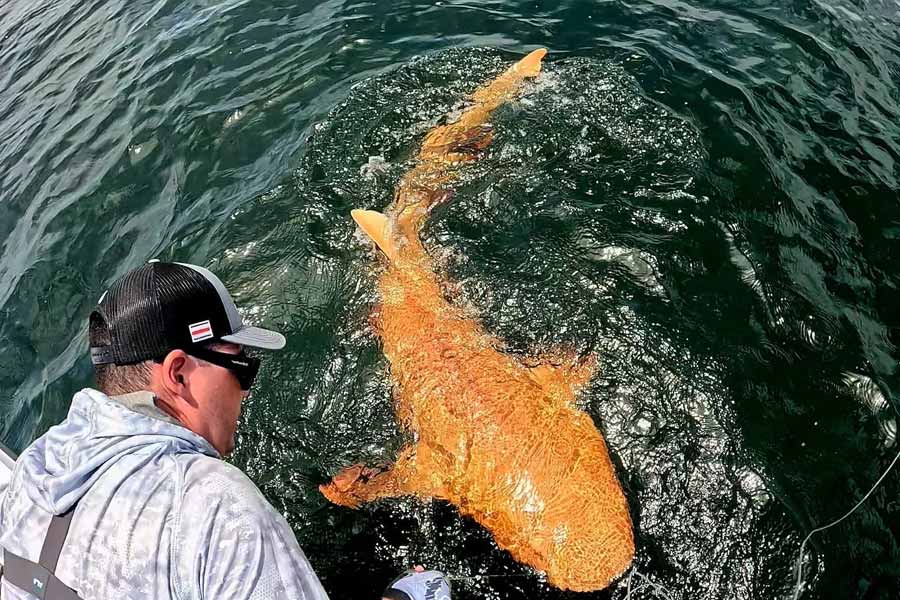You hear the words neon orange shark and think someone’s spinning a tall tale. Not this time. Off Costa Rica, a fisherman hauled up a creature painted straight from a child’s crayon box. It glowed, we stared, and the sea offered no explanations beyond wonder.
Neon orange shark
The catch happened on the Caribbean side, near the village of Parismina. Hotel owner Garvin Watson felt a heavy pull, reeled in, and froze. A nurse shark surfaced, glowing orange, not sunlit bronze. It measured about 6.6 feet, roughly two meters, and was swimming near 120 feet. The crew snapped photos, eased the hook out, and let the fish go. The story spread fast, yet the moment stayed intimate and almost private.
Seeing a neon orange shark in bright water feels like meeting a myth at arm’s length. Nurse sharks usually wear muted clothes, sandy yellow to dusty gray-brown. This one looked dipped in mango paint. Sun hit the water and the color answered back. Watson and his crew were stunned and a little giddy. They did what good anglers do, document, breathe, release.
Two pigments, one wild canvas
What gave the shark its glow wasn’t paint, but pigment. Researchers saw signs of xanthism, also called xanthochroism, which ramps up yellow tones across the skin. They also noticed albinism, suggested by pale eyes and a washed iris where black usually lives. That pair of traits makes a strange duet, rare on any reef. A recent paper in Marine Biodiversity laid out the evidence with careful language and clear images. Past reports hinted at odd colors in nurse sharks, mostly whispers and maybes. This time, the case felt solid, with photos, witnesses, and measurements that hold. A similar blend showed up in a ray in 2018, proof that nature loves surprise.
For a field obsessed with detail, that’s a bright clue worth savoring. And there it was again, the neon orange shark tale becoming more than a lucky snapshot. The species goes by Ginglymostoma cirratum in the books. The photos showed pale eyes, not the inky irises you expect. Scientists compared notes, checked measurements, and filed the report. They avoided guesses and stuck to what the images showed. The takeaway felt simple and bold at once. One animal, two pigment stories, and a color that refused to whisper.
What breaks the color rules
Color in wildlife isn’t just decoration. It’s survival gear, tuned over time by dark water, moonlight, and teeth. So why did this fish wear such a loud suit and still grow into adulthood? Maybe it hunted where color mattered less, like nights around piers or silty bottoms. Maybe predators just missed it in churning water and mottled light. Genetics likely wrote the first draft, with mutations changing how pigment gets laid down. Stress, warmer water, or hormones could have pressed on the same levers at the right moment. Scientists know the pathways are tangled, and the sea loves to keep secrets. Still, a neon orange shark forces fresh questions about camouflage, mating, and the cost of standing out.
It also nudges us to remember how much remains unseen in shallow, ordinary places. The ocean edits slowly, yet some edits shout in day-glo italics. Predators cue on movement first, color second, especially in rough water. At depth, oranges mute fast, fading toward brown and gray. That could help a bright fish blend when the sun sits high. Mating choices play a role too, though the rules are messy. Nature tolerates oddities when they don’t cost too much. Every reef keeps a ledger; sometimes it forgives the splashy entries.
From a boat deck to a bigger story
Watson said the glow made everyone quiet. They stared, laughed a little, and moved with careful hands. Photos came first, release followed, the kind of respect that keeps a story honest. You can feel their disbelief through the pictures, like sunlight caught in a jar. Citizen science thrives on moments like this, brief flashes that push researchers to look again. Local fishers noticed a color that refused to blend, and the world took notice. A neon orange shark seen by chance grew into published work and wider collaboration. It ties a boat deck, a small village, and a global reader into the same circle.
Stories move people, and people move science along. Say the words neon orange shark out loud, and watch faces light like vacation postcards. It’s rare, yes, but it’s also a reminder that the ocean still writes surprises. There is awe in that, and a little joy that feels hard to explain. Some days, science starts with a gasp, not a grant. News raced across group chats and dockside counters. Kids pointed at screens and asked if sharks come in flavors. The answer is yes, in a way only nature invents. Catch and release kept the tale from turning sour. If you fish those waters, keep a camera close and your hands gentle. One bright encounter widened the map we thought we knew. And somewhere under the next glitter of waves, another story waits its turn.
